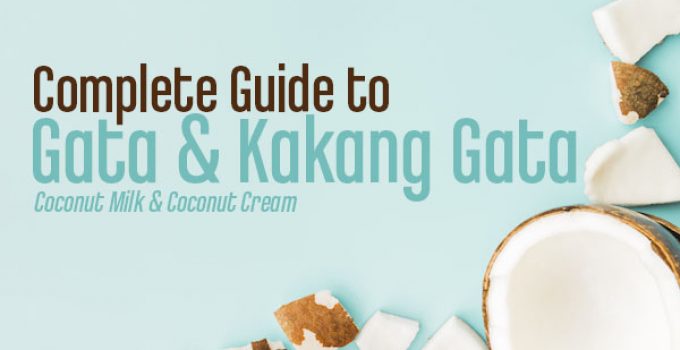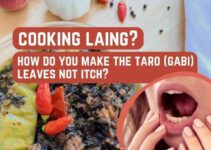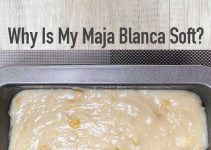Coconut milk products play an important role in Asian cuisines. In case you are wondering what they are, these are basically the liquid obtained by pressing grated coconut meat (from matured coconuts or niyog) with or without added water.
Here in the Philippines, the two major coconut milk products that are commonly used are gata or coconut milk and kakang gata or coconut cream. In this guide, we will tell you how they differ from one another, how to make them, when do we use them, some good-to-know health benefits, as well as some equipment you could use.
Gata vs. Kakang Gata (Coconut Milk vs. Coconut Cream)
Have you ever wondered what is the difference between gata and kakang gata? Maybe you just thought of it as regional word variations across the Philippine islands? Let us explain that for you.
Kakang gata or coconut cream is the “first extraction” of coconut milk you get from pressing grated matured coconut meat (niyog). It is pure and it is thicker than the second and third extraction of coconut milk. Gata or coconut milk refers to the second and third extraction of the grated coconut meat. It is basically a thinner liquid compared to kakang gata.
How to make kakang gata?
Kakang gata or coconut cream is easier to extract through mechanical pressing. However, most Filipinos do not have a coconut presser or extractor in their homes.
The easiest option is to buy it directly from the nearest wet market. But normally, many Filipinos extract their own kakang gata at home. This is also the best way to ensure that you are having your purest and freshest kakang gata. Below are the four easy steps:
Step 1: Put the grated coconut in a large bowl.
Step 2: Pour ½ cup of hot water for every one grated coconut. Since it is challenging to manually extract kakang gata, water acts as a catalyst in this case. Allow it to cool for 5 minutes or until it is bearable for you to touch it.
Step 3: Mash it with your hands several times. This process will help you easily extract the milk from the pulp.
Step 4: Put the pulp into a clean cloth and gently squeeze until the milk comes out.
How to make gata?
Gata or coconut milk (second and third extraction) can be made through these four easy steps:
Step 1: After making the first extraction or kakang gata, put back the grated coconut into the large bowl.
Step 2: Pour 1 cup of hot water for every one grated coconut. Allow it to cool for 5 minutes or until it is bearable for you to touch it.
Step 3: Mash it with your hands several times. This process will help you easily extract the milk from the pulp.
Step 4: Put the pulp into a clean cloth and gently squeeze until the milk comes out.
How long will fresh gata last?
Gata (coconut milk) or kakang gata (coconut cream) can easily get spoiled, so it’s advisable to use it right away. If in case you have to save them for later, store them in a refrigerator. You may store them for a week but cases of contamination may occur during your preparation and cause them to spoil faster.
Remember to check your gata before using them.
If you are storing opened canned or packaged gata, they may last a little longer in your refrigerator. 7-10 days for kakang gata and 7 days for gata.
When to use gata and kakang gata?
Probably, the next question that comes into your mind is when should you use gata (coconut milk) and kakang gata (coconut cream). Below are the possible questions that you may encounter while cooking ginataan dishes:
Can I use gata and kakang gata both at the same time?
When cooking, you cannot use gata and kakang gata both at the same time. If you do this, you cannot fully utilize the function of each coconut milk product.
Gata is usually used at the first stage of the cooking process. It is used to soften or tenderize your meat and vegetables. You may think: ‘I can also do that with water, why bother using coconut milk?’ Right. But remember, if you want to make your dishes more delicious and flavorful, use coconut milk for the same purpose (only when you’re cooking ginataan dishes, of course).
Kakang gata on the other hand is added at the later part of the cooking process. Primarily, it makes your ginataan dishes creamier and tastier. If you really want your ginataan dishes to achieve the true taste of authentic Filipino cuisine, always choose fresh kakang gata over other creamers.
What will happen if I use kakang gata only? Or how about when I use gata only?
You can still make ginataan dishes if you only use kakang gata or gata alone. Essentially, if you use pure kakang gata all throughout your cooking process, you will need more of it. You’d probably need to double or triple the amount of kakang gata to cook your meat or vegetables.
Actually, there are ginataan recipes that call for pure kakang gata in the entire cooking process. One example is kinunot of the Bicol region.
Moreover, if you use gata only, you will end up with less creamy ginataan dishes. There is no other important factor to discuss here. Remember gata is thinner than kakang gata –if you use it alone, you will have a less creamy and less tasty dish.
What are the health benefits of gata and kakang gata?
Did you know that gata (coconut milk) and kakang gata (coconut cream) are not just great for cooking but also provide you health benefits?
We have studied several works on health benefits of coconut milk products and we’ve found out that coconut milk fat has been reported to improve digestion and bowel function.
It also supports tissue repair and immune system functions, helps protect the body from breast colon and other cancers, improve cholesterol ratio, and reduce risk of heart disease and increase the metabolic rate of body fat, among other benefits.
Coconut milk products are also rich in proteins such as albumim, globulin, prolamin, and glutein.
Additional Information: Basic Equipment Used for Coconut Milk Products Extraction
- Deshelling Machine – for removal of the coconut shell
- Grinder/ Pulverizer – reduces the particle size of coconut meat, for a more efficient milk extraction
- Grater – motorized coconut shredder, used after coconut is split into halves
- Coconut milk extractor – for mechanical extraction of coconut milk from the grated coconut meat
Photo by: Stephanie Booth (CC BY-NC-SA 2.0)
Images: Background photo created by freepik – www.freepik.com
Pin this recipe on Pinterest!
Thank you and I hope you find this article useful! It’ll mean a lot if you SHARE THIS TO YOUR FRIENDS! 🙂



